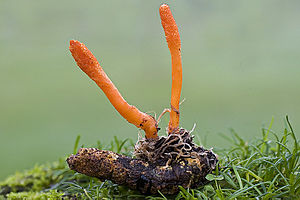Doll core club
| Doll core club | ||||||||||||
|---|---|---|---|---|---|---|---|---|---|---|---|---|

Pupa core club ( Cordyceps militaris ) |
||||||||||||
| Systematics | ||||||||||||
|
||||||||||||
| Scientific name | ||||||||||||
| Cordyceps militaris | ||||||||||||
| ( L. ) Link |
The pupa core club ( Cordyceps militaris ) is a mushroom from the department of the ashlar that parasitizes on butterfly pupae . The German Society for Mycology voted it mushroom of the year 2007.
features
Macroscopic features
The mushroom forms two to five centimeters high, club-shaped and yellow-orange fruiting bodies that grow out of the dead, buried pupae. The club is covered with the stroma into which the actual fruiting bodies, the perithecia, are sunk. This makes the surface appear rough dotted. The trama, i.e. the inner fungal tissue, is whitish to pale orange.
Microscopic features
The spores are smooth, hyaline , long thread-like and often septate. When ripe, they disintegrate into 3 to 7 × 1 to 1.2 μm large partial spores. The asci are long cylindrical. Sometimes one is anamorphic formed which Isaria farinosa is called. It forms thin, whitishly dusted forms on the pupae. However, it is not certain that it is the same species.
Ecology and diffusion
The pupa core club lives on dead pupae of various large butterflies, rarely also on caterpillars. Depending on the author, it is rare to quite common, distributed throughout the northern hemisphere and forms fruiting bodies in Europe from August to November.
ingredients
The mushroom contains anti-inflammatory polysaccharides , which are also effective against tumors and their metastases . The ingredient cordycepin kills bacteria . Furthermore, in traditional Chinese medicine it is ascribed an aphrodisiac , lung and kidney strengthening effect. The mushroom is also used in Asia as a medicine against colds and as a doping agent .
literature
- Bon, Marcel: Parey's book of mushrooms , Hamburg, Berlin 1988, ISBN 3-490-19818-2
- Ewald Gerhardt: Mushrooms. BLV Buchverlag, Munich 2006, ISBN 3-8354-0053-3 , p. 551.
Individual evidence
- ↑ Mushroom of the year 2007: Cordyceps militaris (L.) Link, Puppenkernkeule
Web links
- Cordyceps militaris in the Fungorum Index
- Mushroom of the year 2007
